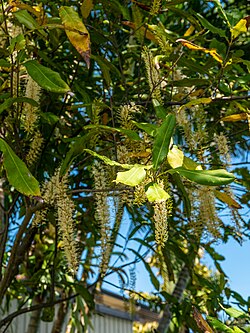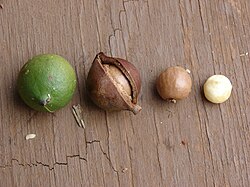Biology:Macadamia integrifolia
| Macadamia integrifolia | |
|---|---|

| |
| Inflorenscences and foliages of Macadamia integrifolia at Geebung, Queensland | |

| |
| Different stages of Macadamia integrifolia nut | |
| Scientific classification | |
| Kingdom: | Plantae |
| Clade: | Tracheophytes |
| Clade: | Angiosperms |
| Clade: | Eudicots |
| Order: | Proteales |
| Family: | Proteaceae |
| Genus: | Macadamia |
| Species: | M. integrifolia
|
| Binomial name | |
| Macadamia integrifolia Maiden & Betche
| |
Macadamia integrifolia is a small to medium-sized tree, growing to 15 metres in height. Native to rainforests in south east Queensland and northern New South Wales, Australia . Common names include macadamia, smooth-shelled macadamia, bush nut, Queensland nut, Bauple nut and nut oak.[2]
Description
Macadamia integrifolia leaves are simple, oblong in shape, glossy, entire with wavy leaf margins and are 20 cm long and 10 cm wide.[3] The flowers are white or pink followed by woody, edible rounded fruits[4] which are 2 to 3.5 cm in diameter.
This tree is rarely cultivated for ornamental purposes.[2]
It has been introduced to Mexico and has done well in the states of Michoacán and Jalisco.[5]
The trees will survive in hardiness zones 10 and 11.[citation needed]
The trees in Australia can be affected by a fungal pathogens from the Neopestalotiopsis genus and the Pestalotiopsis genus (both are within Sporocadaceae family), they both cause flower blight.[6][7]
See also
- Macadamia nuts
References
- ↑ Forster, P.; Griffith, S.; Ford, A.; Benwell, A. (2020). "Macadamia integrifolia". IUCN Red List of Threatened Species 2020: e.T113180064A113310165. doi:10.2305/IUCN.UK.2020-3.RLTS.T113180064A113310165.en. https://www.iucnredlist.org/species/113180064/113310165. Retrieved 18 November 2021.
- ↑ 2.0 2.1 Department of the Environment (2020). "Species Profile and Threats Database: Macadamia integrifolia". Department of the Environment, Canberra. https://www.environment.gov.au/cgi-bin/sprat/public/publicspecies.pl?taxon_id=7326.
- ↑ "Australian Native Plants Society (Australia)". http://anpsa.org.au/m-int.html.
- ↑ Hargreaves, Dorothy; Hargreaves, Bob (1964). Tropical Trees of Hawaii. Kailua, Hawaii: Hargreaves. p. 40.
- ↑ Marisela Taboada & Rogelio Oliver Guadarrama. 2004. Cultivos alternativos en México. Universidad Autónoma del Estado de Morelos. Centro de Investigaciones Biológicas. AGT Editor S.A. Mexico City, Mexico. ISBN:968-463-120-0
- ↑ Prasannath, Kandeeparoopan; Shivas, Roger G.; Galea, Victor J.; Akinsanmi, Olufemi A. (17 September 2021). "Neopestalotiopsis Species Associated with Flower Diseases of Macadamia integrifolia in Australia". J Fungi (Basel) 7 (9): 771. doi:10.3390/jof7090771. PMID 34575809.
- ↑ Akinsanmi, O.A.; Nisa, S.; Jeffego, O.S.; Drenth, A. (2016). "Multiple Pestalotiopsis and Neopestalotiopsis species cause flower blight of macadamia in Australia.". Phytopathology 106 (12): 122‑122.
Other sources
- "Macadamia integrifolia". Australian Plant Name Index (APNI), IBIS database. Centre for Plant Biodiversity Research, Australian Government. http://www.anbg.gov.au/cgi-bin/apni?taxon_id=46190.
- G. J. Harden. "New South Wales Flora Online: Macadamia integrifolia". Royal Botanic Gardens & Domain Trust, Sydney, Australia. http://plantnet.rbgsyd.nsw.gov.au/cgi-bin/NSWfl.pl?page=nswfl&lvl=sp&name=Macadamia~integrifolia.
Wikidata ☰ Q311178 entry
 |


